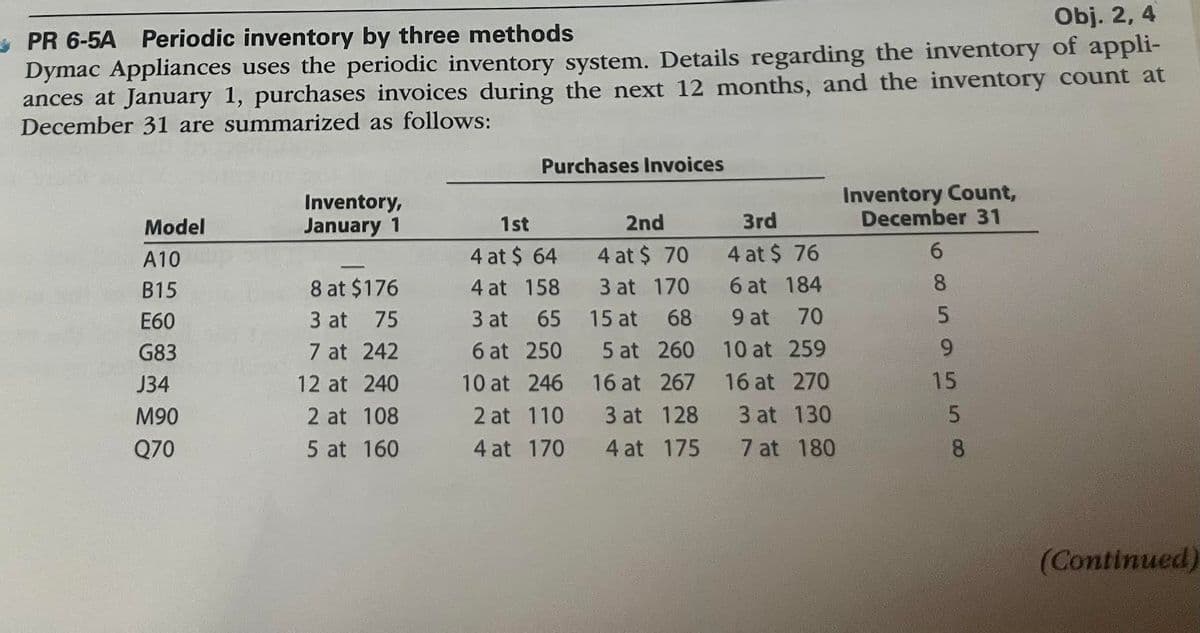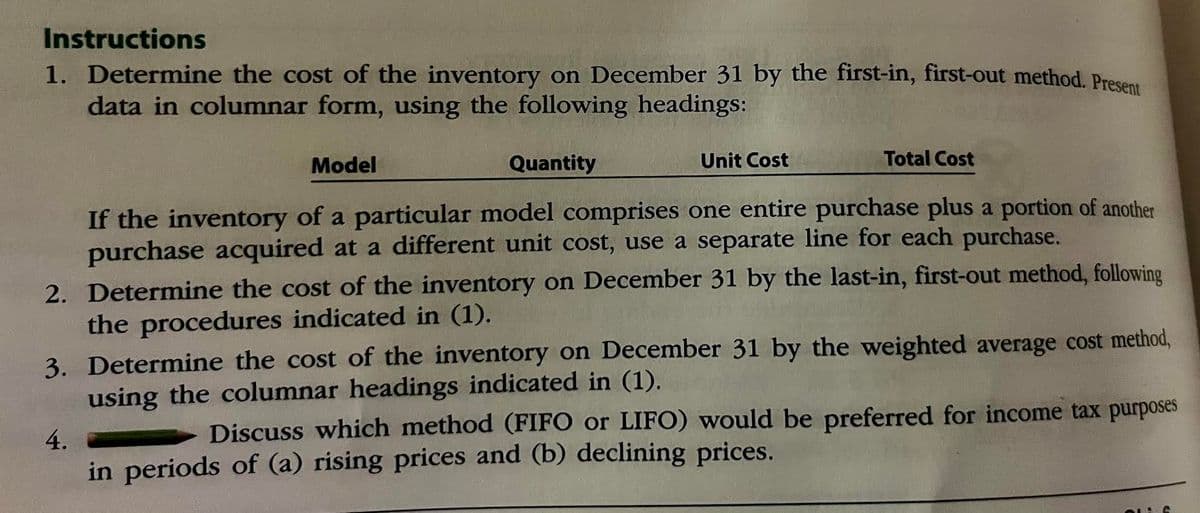Instructions 1. Determine the cost of the inventory on December 31 by the first-in, first-out method. Present data in columnar form, using the following headings: Quantity Unit Cost Model Total Cost If the inventory of a particular model comprises one entire purchase plus a portion of another purchase acquired at a different unit cost, use a separate line for each purchase. 2. Determine the cost of the inventory on December 31 by the last-in, first-out method, following the procedures indicated in (1). 3. Determine the cost of the inventory on December 31 by the weighted average cost method, using the columnar headings indicated in (1). 4. Discuss which method (FIFO or LIFO) would be preferred for income tax purposes in periods of (a) rising prices and (b) declining prices.
Instructions 1. Determine the cost of the inventory on December 31 by the first-in, first-out method. Present data in columnar form, using the following headings: Quantity Unit Cost Model Total Cost If the inventory of a particular model comprises one entire purchase plus a portion of another purchase acquired at a different unit cost, use a separate line for each purchase. 2. Determine the cost of the inventory on December 31 by the last-in, first-out method, following the procedures indicated in (1). 3. Determine the cost of the inventory on December 31 by the weighted average cost method, using the columnar headings indicated in (1). 4. Discuss which method (FIFO or LIFO) would be preferred for income tax purposes in periods of (a) rising prices and (b) declining prices.
Intermediate Accounting: Reporting And Analysis
3rd Edition
ISBN:9781337788281
Author:James M. Wahlen, Jefferson P. Jones, Donald Pagach
Publisher:James M. Wahlen, Jefferson P. Jones, Donald Pagach
Chapter8: Inventories: Special Valuation Issues
Section: Chapter Questions
Problem 13E: Retail Inventory Method The following information relates to the retail inventory method used by...
Related questions
Question

Transcribed Image Text:Obj. 2, 4
PR 6-5A Periodic inventory by three methods
Dymac Appliances uses the periodic inventory system. Details regarding the inventory of appli-
ances at January 1, purchases invoices during the next 12 months, and the inventory count at
December 31 are summarized as follows:
Model
A10
B15
E60
G83
J34
M90
Q70
Inventory,
January 1
8 at $176
3 at 75
7 at 242
240
2 at 108
5 at 160
12 at
Purchases Invoices
1st
4 at $ 64
4 at 158
3 at
65
6 at
250
10 at
246
2 at
110
4 at 170
2nd
4 at $ 70
3 at
170
15 at
68
5 at
260
16 at
267
3 at
128
4 at
175
3rd
4 at $ 76
6 at
184
9 at
70
10 at
259
16 at
270
3 at
130
7 at 180
Inventory Count,
December 31
6
8
5
9
15
558
(Continued)

Transcribed Image Text:Instructions
1. Determine the cost of the inventory on December 31 by the first-in, first-out method. Present
data in columnar form, using the following headings:
Quantity
Unit Cost
Model
Total Cost
If the inventory of a particular model comprises one entire purchase plus a portion of another
purchase acquired at a different unit cost, use a separate line for each purchase.
2. Determine the cost of the inventory on December 31 by the last-in, first-out method, following
the procedures indicated in (1).
3. Determine the cost of the inventory on December 31 by the weighted average cost method,
using the columnar headings indicated in (1).
4.
Discuss which method (FIFO or LIFO) would be preferred for income tax purposes
in periods of (a) rising prices and (b) declining prices.
Expert Solution
This question has been solved!
Explore an expertly crafted, step-by-step solution for a thorough understanding of key concepts.
This is a popular solution!
Trending now
This is a popular solution!
Step by step
Solved in 5 steps

Knowledge Booster
Learn more about
Need a deep-dive on the concept behind this application? Look no further. Learn more about this topic, accounting and related others by exploring similar questions and additional content below.Recommended textbooks for you

Intermediate Accounting: Reporting And Analysis
Accounting
ISBN:
9781337788281
Author:
James M. Wahlen, Jefferson P. Jones, Donald Pagach
Publisher:
Cengage Learning

Cornerstones of Financial Accounting
Accounting
ISBN:
9781337690881
Author:
Jay Rich, Jeff Jones
Publisher:
Cengage Learning

Financial And Managerial Accounting
Accounting
ISBN:
9781337902663
Author:
WARREN, Carl S.
Publisher:
Cengage Learning,

Intermediate Accounting: Reporting And Analysis
Accounting
ISBN:
9781337788281
Author:
James M. Wahlen, Jefferson P. Jones, Donald Pagach
Publisher:
Cengage Learning

Cornerstones of Financial Accounting
Accounting
ISBN:
9781337690881
Author:
Jay Rich, Jeff Jones
Publisher:
Cengage Learning

Financial And Managerial Accounting
Accounting
ISBN:
9781337902663
Author:
WARREN, Carl S.
Publisher:
Cengage Learning,

Survey of Accounting (Accounting I)
Accounting
ISBN:
9781305961883
Author:
Carl Warren
Publisher:
Cengage Learning

Principles of Accounting Volume 1
Accounting
ISBN:
9781947172685
Author:
OpenStax
Publisher:
OpenStax College

Financial Accounting
Accounting
ISBN:
9781337272124
Author:
Carl Warren, James M. Reeve, Jonathan Duchac
Publisher:
Cengage Learning